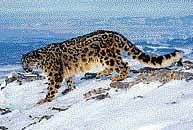
The WWF has found vital clues to the presence of the endangered snow leopard after two long years of field trips and search in these two states. The finding is significant as not much is known about the snow leopard in the Indian Himalayas. The WWF-India conducted field surveys in 2008–2009 in these two states, with support from forest departments. For the first time in the country, DNA samples were collected to establish the discovery. And the analysis was done by the Wildlife Institute of India (WII) in Dehradun.
Several areas in the two states were identified as probable habitats of the snow leopard after discussion with experts. This was done to assess the occurrence and distribution, as well as to study the conflict between humans and snow leopard, its co-predators and prey species.
Aishwarya Maheshwari, Senior Project Officer from WWF-India, spent months in the Himalayas, trying to spot the elusive cat. “Before the survey started, quite a few people expressed apprehensions about my ambition,” he said.
Maheshwari, who was instrumental in discovering snow leopard in the Kargil area, climbed tall mountains and braved snow storms, but he was unable to spot the elusive animal throughout the survey. But this did not disappoint him. “The signs were there — scat (excreta), scrape (a mark with hind paw consisting of an oblong depression with a pile of earth at one end), pug-marks, kills, and spray/urine and claw marking. During this survey, only twice did I see pugmarks. I came across scat of snow leopard at least 10 times,” he adds. This helped him obtain DNA samples for testing.
The study covered the Askot Wildlife Sanctuary, Nanda Devi Biosphere Reserve, Gangotri National Park, Valley of Flower National Park, Tundah Wildlife Sanctuary, Great Himalayan National Park and Lippa Asrang Wildlife Sanctuary.
The WWF-India proposes the Gangotri National Park, Askot Wildlife Sanctuary and Nanda Devi Biosphere Reserve as potential habitats for snow leopard under the “Project Snow Leopard” being implemented by the Ministry of Environment & Forests. The WWF-India noted poor management and inadequate field staff at these places. It has recommended better management and infrastructure for these protected areas in both states.